Change, modify, or delete recurring schedule
Change a recurring schedule
When you change any parameter of a job that is a part of a recurring schedule, you may come across some job, resource, or time-related conflicts. The parameter you wish to change for a job in a recurring schedule may no longer be a viable option because of the conflict it may bring.
For example, if you wish to change or add a resource to a job in the recurring schedule. On that particular day, the resource is unavailable. Then scenarios like this can create conflicts in the successful completion of the job. In such a scenario, a prompt like the following notifies you of the conflicts so that you are aware of them:
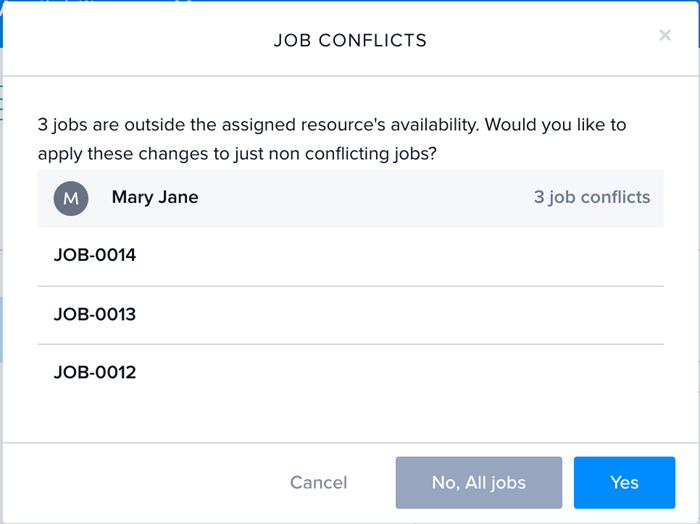
Here, you can choose to apply the changes to just the non-conflicting job by clicking Yes, or to all the jobs by clicking No, All jobs. Or you can revert your changes by clicking Cancel.
Changing the start date of a job in a recurring schedule
If a scheduler decides to change the start date of a job in a recurring schedule, they will first be presented with a save confirmation popup, followed by an Update Recurring Pattern modal.
This modal enables the scheduler to reconfigure all future jobs in the series. The following advice is given in the modal: “By updating your recurring schedule all future jobs will be modified to reflect your new pattern. If your schedule is extended new jobs will be added. Similarly, if you shorten your schedule, jobs that fall outside your pattern will be canceled.”
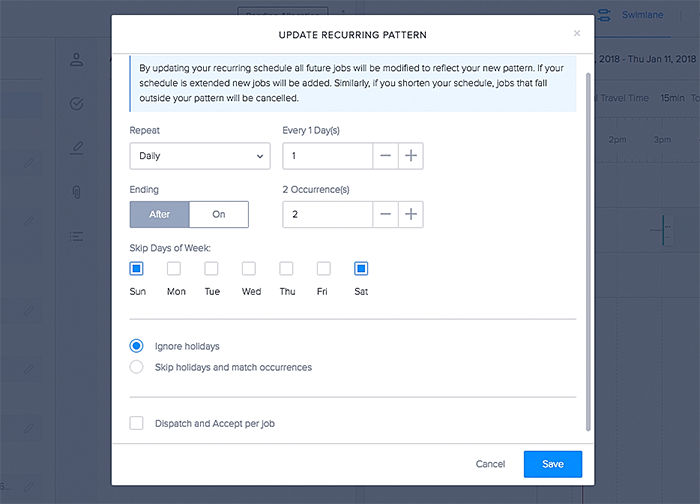
Important
To be able to change any part of a recurring pattern you need to trigger the update modal by changing the date of the recurring schedule.
Changes cannot be applied to jobs (within the series) that have a lower job name than the currently selected job.
Allocate or deallocate resources on a recurring schedule
Schedulers can allocate (or deallocate) all (or any subset of) jobs in a recurring schedule. From the recurring schedule page, both the Allocate and Deallocate action buttons will appear at the top of the page once one or more jobs are selected.
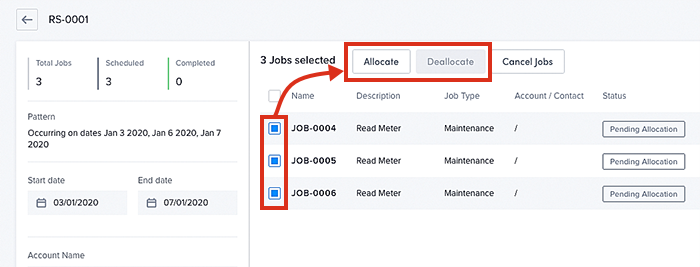
Once Allocate is selected, the Allocate to jobs modal opens from which the scheduler can select one or more resources to add to the jobs in the recurring schedule.
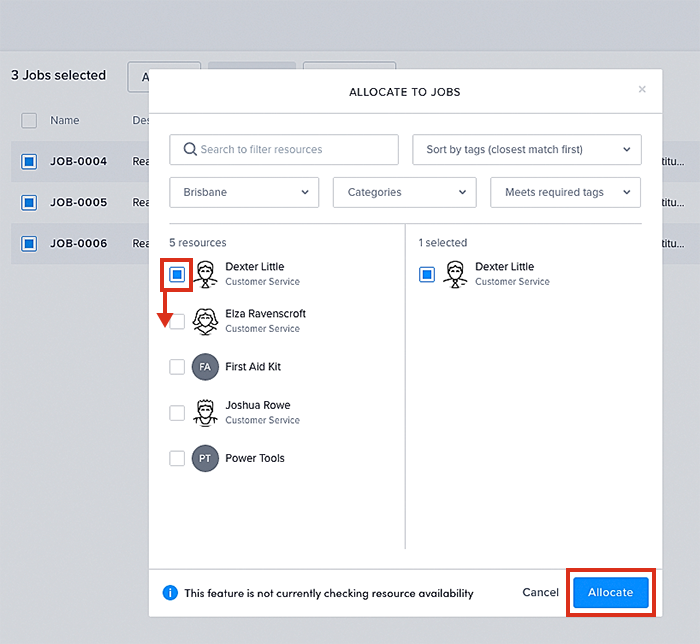
If Deallocate is selected, a confirmation pop-up will ask the scheduler to confirm the deallocation.

Note
Concerning allocation:
- The button will be disabled if the organization has Multiple resource requirements enabled.
- The resource selection modal does not filter out unavailable resources (due to multiple jobs).
- You can allocate to any job that is not locked.
Concerning deallocation:
- The button will be disabled if the organization has Multiple resource requirements enabled.
- The button will be enabled when the selected job(s) contain valid allocations. Invalid allocations include:
- On locked jobs.
- On completed jobs.
- “In Progress” or “Checked In” jobs.
- Once selected, it will produce the same behavior as when bulk deallocating from the jobs table, console, swimlane or job pages (new and old). A single toast message will state how many jobs have been updated.
Copy and replace tasks on a recurring schedule
A scheduler can copy and replace tasks to all following jobs in a recurring schedule. After confirming the action, all tasks on upcoming jobs in the recurring schedule will be replaced with the tasks on the current job.
The following rules apply:
- Any tasks on the recurring jobs, starting at the same time or after the current job, will be overwritten to match the task list on the selected job.
- Queued jobs (with no start time) will not be updated.
- A loading indicator (spinner) will be displayed while waiting for a response from the API.
- Once successful, a toast message will be displayed to confirm the update.
- If there is an error, a toast message will be displayed to say that the update failed.
- If the job that is the basis for the update does not have a start time, all jobs in the recurring schedule will be updated.
- The task order will be maintained.
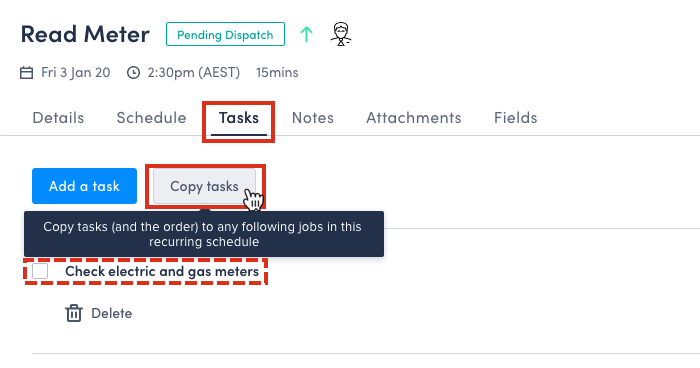
Copying a job task in a recurring schedule.
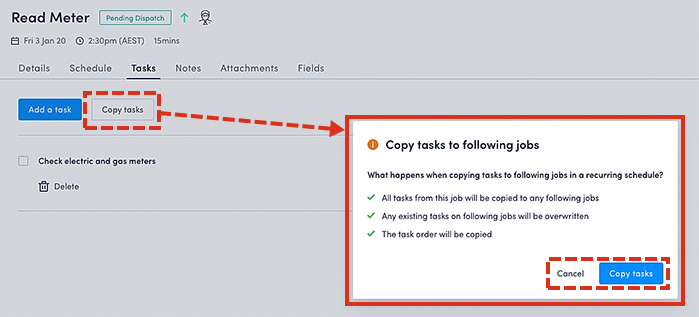
The confirmation pop-up for copying tasks in a recurring schedule.
Note
For recurring schedules, tasks can only be copied and replaced using the Job page (via the “Tasks” tab).Canceling jobs on a recurring schedule
The easiest way to cancel jobs on a recurring schedule is via the recurring schedules page of the Jobs console. At the bottom of the page, select the job(s) that are to be canceled, then click the Cancel Jobs button above the list (for multiple cancellations) or select Cancel Job via the three-dot menu (for single jobs).
On cancelation of a job (or several jobs), a prompt will ask you to select a cancelation reason. Select one of the reasons provided by the drop-down list. Once a reason is selected, the blue Yes, cancel button becomes active. Click on this button to cancel the job(s) from the recurring schedule. Click the Cancel button to return to the schedule without making any changes.
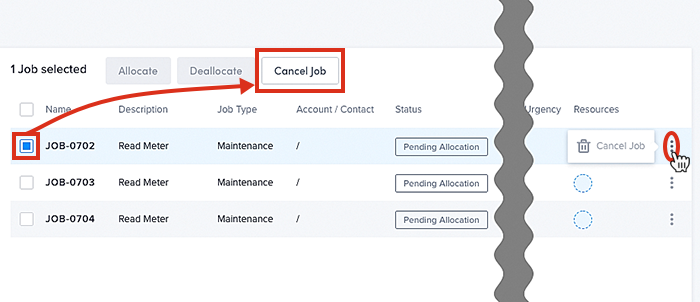
How to cancel jobs on a recurring schedule.
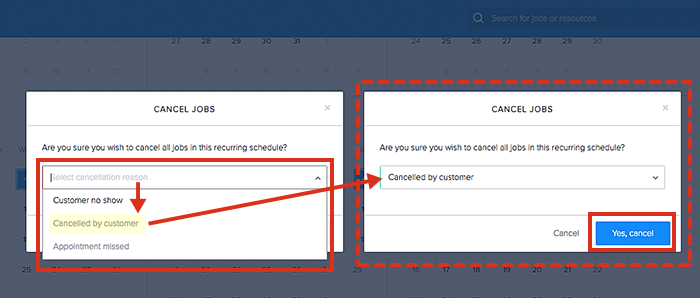
How to provide a reason when canceling jobs from a recurring schedule.
Note
Currently, there is no way to delete a job from a recurring schedule–only cancel is available.Tip
Another way to cancel jobs in a series is via the Job Details view.Dispatch and accept per job
By default, jobs in a recurring schedule are dispatched as a group. If an allocated resource accepts one job in the series, they automatically take all other jobs in that series as well. However, if resources are required to acknowledge each job individually, then there is a setting to be configured.
This setting can be applied to each schedule, or it can be set at a global level–applying to all recurring schedules across the organization.
To set the global setting, go to the admin settings (via the user profile “Settings” option). Under Workflow is a checkbox for recurring schedules which enables the Dispatch and accept per job option.
The setting for acknowledging jobs per recurring schedule can be found at the bottom of the Create Job page’s time tab.
Managing Services on recurring jobs
You may find yourself in a situation where you need to make changes to the services on jobs within a recurring schedule. There are a couple of ways to manage these changes and ensure the changes you make are correctly applied (or not applied) to future jobs in the schedule.
Setting the scene
You have a recurring job that takes place every Monday. During that job, the resource performs 3 services for your client.
Scenario one:
This coming Monday, the client has requested that your resource only completes one of those services. But the client confirms that they only want this change to occur for this job only. From next week everything needs to be back to normal, where the 3 services are completed.
Steps:
- Edit the job you wish to make changes to.
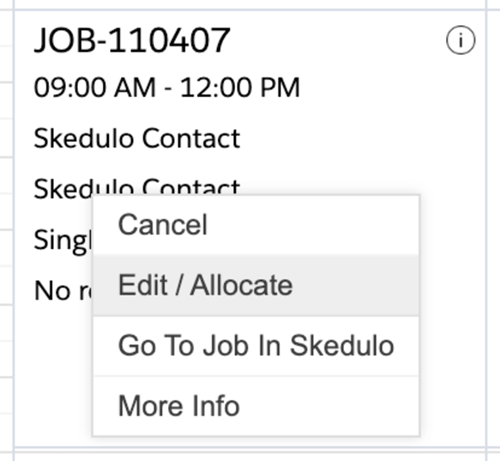
- Remove the services that you would like not completed on this particular job and press Update Job.
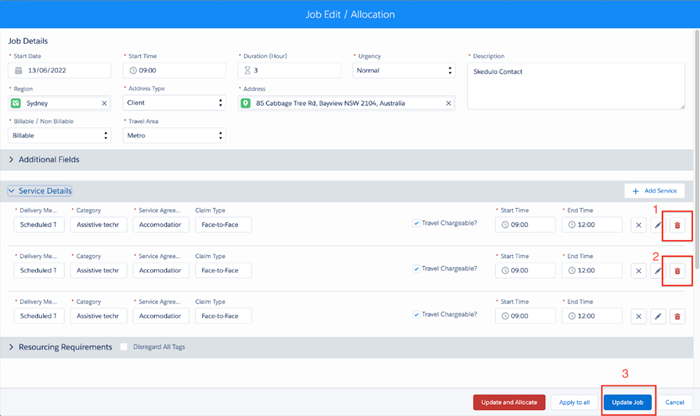
Scenario Two:
From this Monday onwards, the client only wants 2 services provided by the resource. The third service is no longer required and we’d like to remove it completely from the series.
Steps:
- Edit the job you wish to make changes to:

- Remove the no longer required service and press Apply to all.

- You will be presented with the Change Conflicts modal where you need to verify the changes you want applied to all future instances of the recurring schedule. In this case we will select the service we removed and select apply. In this instance you could technically select all services as we did not make changes to the first two. But we will cover an edge case for this in scenario three.
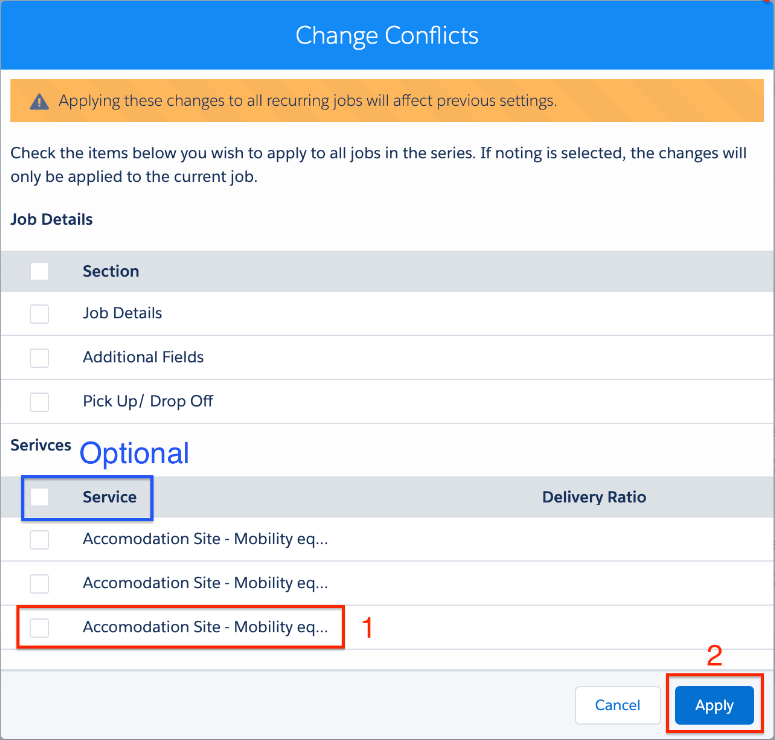
Scenario Three:
From this Monday onwards, the client wants the third service removed completely, but has also asked if the first two services can be done via the phone for this week only as they are sick and do not want the resource visiting them in person.
Steps:
- Edit the job you wish to make changes to:

- Edit the first two services to Telehealth, and at the same time remove the third service and press “Apply to all”.
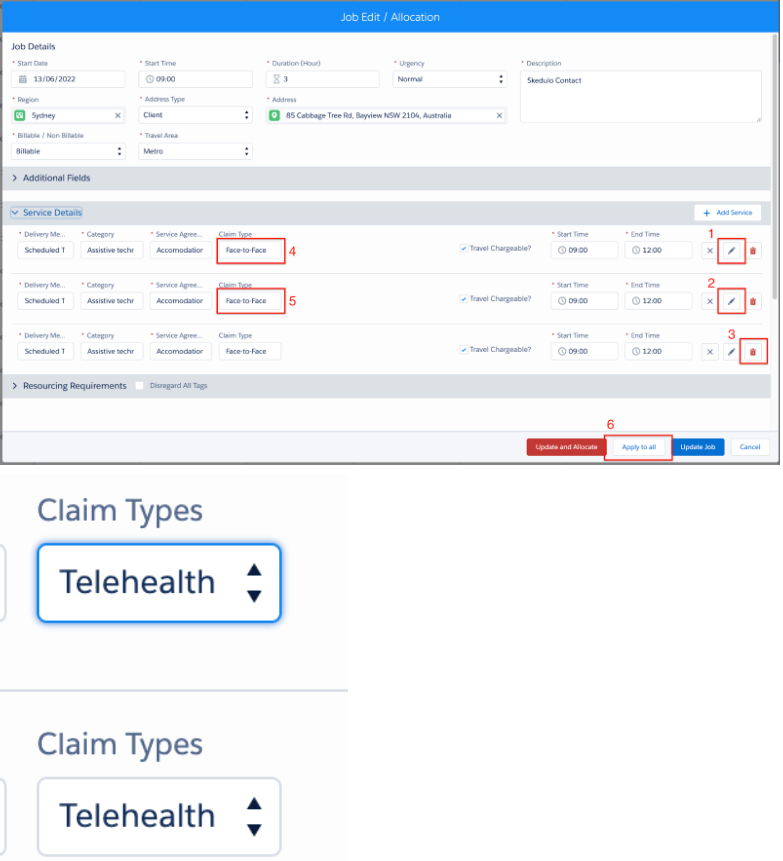
- This time when you are presented with the Change Conflicts modal you want to ensure that you are only selecting the service that you wish to be changed indefinitely (the removed service). By not selecting the two services that you switched to Telehealth, the system will only apply the changes for that particular job.
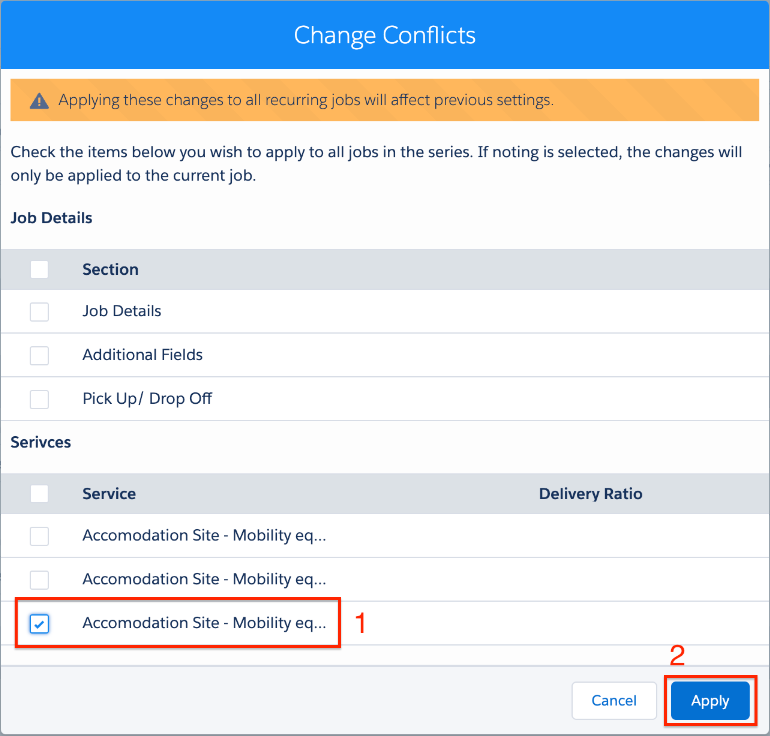
Feedback
Was this page helpful?